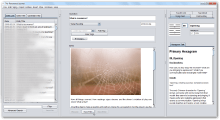A thought on Hexagram 4. We think of Not Knowing as a default state, a starting position: children don’t know at first, so they learn; we start off not knowing, so then we consult the oracle. (Though preferably not for a second and third time…)
In today’s news, the BBC announces the results of a poll about people’s belief in the Resurrection of Jesus and in life after death. They write the headline, ‘Resurrection did not happen, say quarter of Christians.’ Here’s an alternative headline from the same poll: ‘95% of people know for certain whether or not the Resurrection happened.’ Only about 5% of respondents said they didn’t know.
So perhaps not knowing isn’t a default starting position?
Things I’ve noticed about my own mental habits lately: it’s very hard, almost impossible, to stay quietly in a state of not knowing – so much so, in fact, that I’ll whizz through that state at light speed on the way to knowing, barely noticing I was ever there. I ‘know’ what people must mean by their actions. I ‘know’ what I need to do today (and tomorrow and next month): I have a list. (And if I don’t know what to do next, there are always cat videos and chocolate.)
If I don’t know what someone meant, I can ask them. If I don’t know what to do next, perhaps I can be guided. But to make that first consultation, I’ll need at least to stay quiet for long enough to notice that I don’t know.
(I’ve often noticed that Hexagram 4 can describe not only wanting a specific answer, but also just wanting a response of some kind: feedback, validation, or recognition. Maybe another word for what we want is stimulus – stirring up the waters, filling the disconcertingly still space of not knowing with motion. Like I said, if the to-do list fails, there are always cat videos.)
I think that’s how Not Knowing contains its nuclear hexagram: 24, Returning. If ignorance can bring you to a standstill, then you can return, reconnect and get back on track. As the Image of 24 says, it’s not something that happens in the midst of ‘business as usual’.
In his challenging Ted talk, The Gospel of Doubt, Casey Gerald makes a remarkable choice of image to describe his 12-year-old self’s experience, when the Rapture didn’t happen on schedule, of discovering he (and the Church elders) didn’t know after all:
“It was possible the answers I had were wrong, that the questions themselves were wrong. And now, where there was once a mountain of certitude, there was, running right down to its foundation, a spring of doubt, a spring that promised rivers.”











Just turned 71 (you’re only as old as you feel! Well, I’m starting to feel my age) and one problem seems to be I feel I know too much! I’ve been reading a book called “Whatever You Think, Think The Opposite” and it has been useful in jolting me out of well-used neural paths (but not much to show for it yet). Can you use “I” to generate seismic disturbances? What might the process entail? I became resistant some time ago to the idea of ‘Living with “I”‘, much as I respect it, but am curious as to whether it can be approached this way – will the geni(us) turn out to be a demon?
Absolutely. It can be as simple as thinking of something you did and asking, ‘What did I do?’ or something you experienced and asking, ‘What was that?’ And be prepared to have the pieces in the kaleidoscope shaken up to show a wholly new pattern. Then there’s ‘Please show me a guiding principle…’ or even ‘How could I do this differently?’ I’d say that jolting and the occasional earthquake are more or less guaranteed if you keep asking open questions and listening to the answers. Not necessarily earthquakes on demand, though – that would lessen the impact… 😉 (Sometimes the most disconcerting answer might be, ‘You’d do well to carry on as you are.’)
Thank you, Hilary. Your kindness and wisdom have been apparent over the many years I have been acquainted with your work. When I do return to Yi, yours is always one book of interpretations that I consult (yes, I like to use comparative readings – not to select the “best” but to get a differentially faceted view which comes from the mindset of the different interpreters). The approach you mention encourages me to experiment further and I shall be interested to see how my readings turn out in conjuction with my own inner work toward a better acceptance of those increasing years.